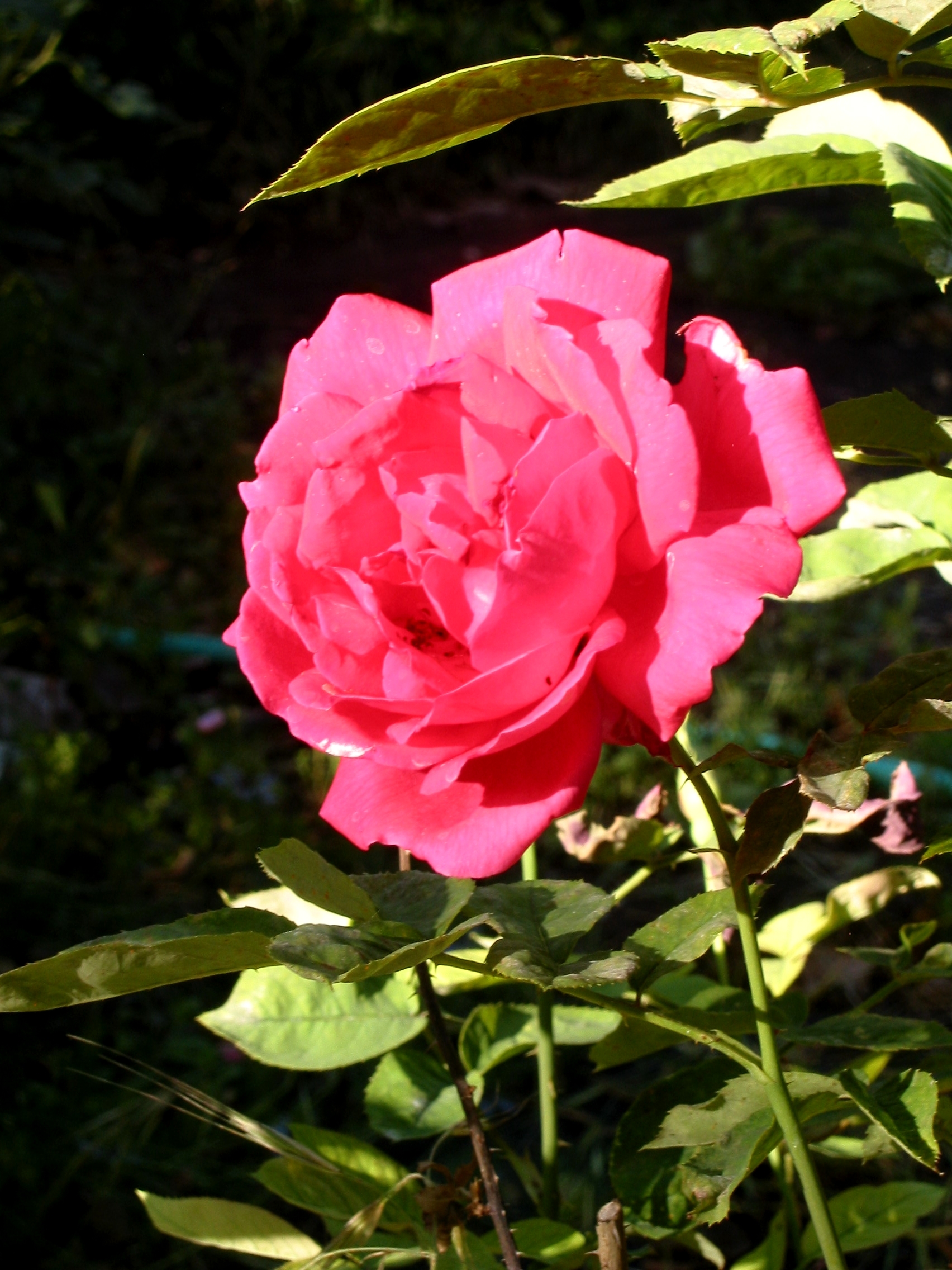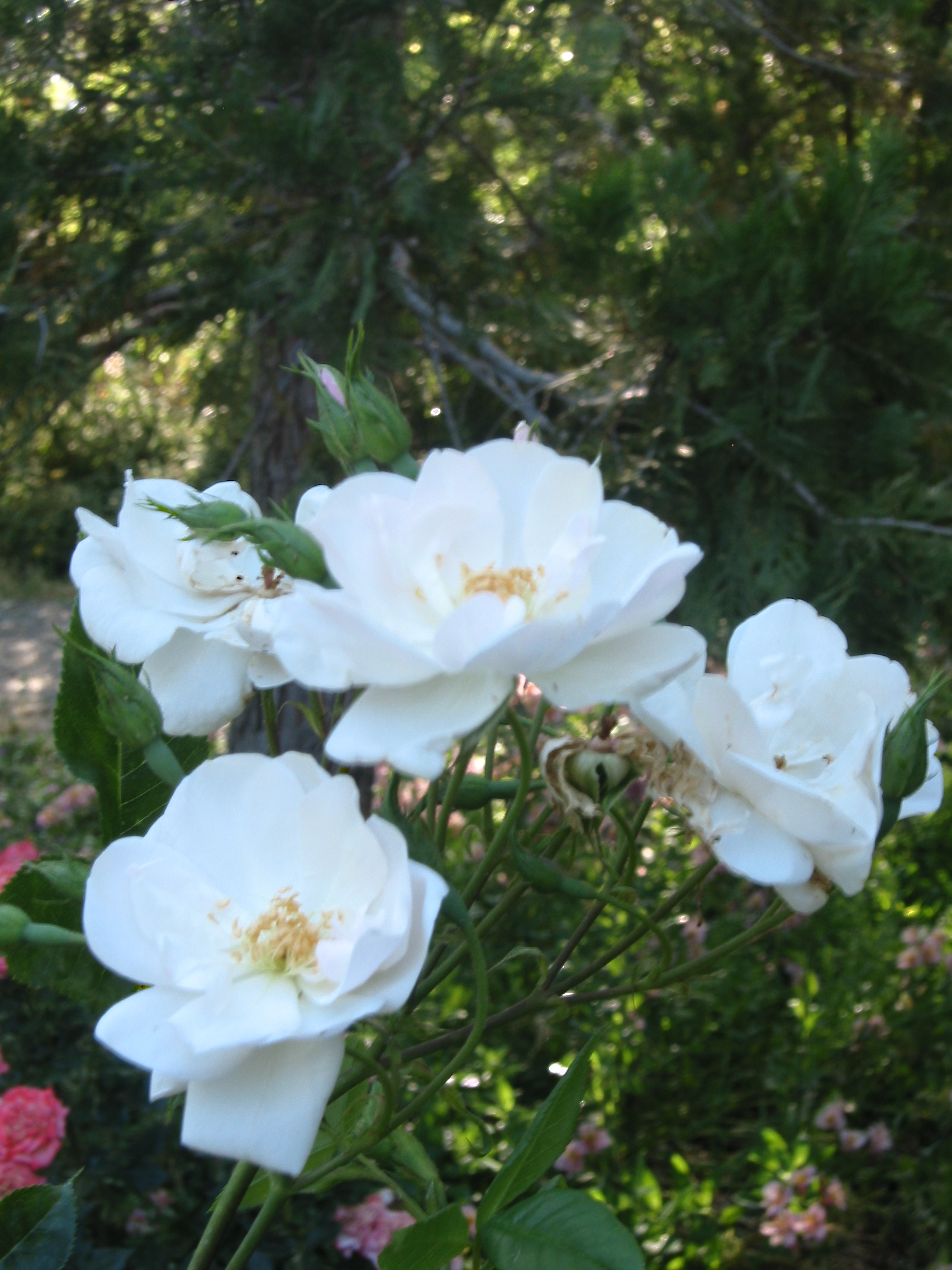From the Davis Enterprise, May 28, 2009
Worms and Roses
O Rose, thou art sick!
The Invisible worm,
That flies in the night,
In the howling storm,
Has found out thy bed
Of Crimson joy;
And his dark secret love
Does thy life destroy.
--William Blake, The Sick Rose
Events have a way of creating column topics. I was all prepared to write about my favorite roses, chatting about fragrance and abundance of blooms. Then we had a visit early this week from employees of the Yolo County Agricultural Commissioner's office. This morning an officer of the USDA stopped by.
In April a single Light Brown Apple Moth was found near the freeway in south Davis. This little quarter-inch-size brown moth produces caterpillar larvae which feed on over 1000 species of plants. As I said then, "it doesn't happen to eat olives, tomatoes, or walnuts. It does eat all the other major crop plants of Yolo County, including almonds, citrus, corn, grapes, stone fruits (apricots, cherries, nectarines, peaches, plums) and sunflowers. Not to mention many of the plants in your garden and landscape."
Last week this very newspaper again featured the little moth, which we now affectionately call LBAM (say "el Bam!"), right on the front page. More moths found, this time in central Davis. The story presented the impact of LBAM on local agriculture, but missed the most immediate effect of this second discovery: every business that sells plants in the city limits of Davis is now in an agricultural quarantine district. That includes the nursery and hardware store, and local pharmacies and grocery stores that sell plants.
Quarantine. Now there's a word that you don't like to see applied to the source of your livelihood. But please note: plants from your favorite local garden shop are perfectly safe for you to buy, take home, and plant! In order to sell plants legally in California a vendor must have a license to sell nursery stock, subjecting us to inspections and regulations enforced by the county ag commissioner. It is not legal to grow and sell plants without such a license, such as at garage sales. LBAM is thoroughly established in the Bay Area, so it is important that you NOT bring plants, vegetation, cut flowers, fruits or vegetables in to Davis unless they were purchased at a retail sales location there.
Staff from the Yolo County Agricultural Commissioner's office have inspected every inch of local plant-selling businesses. The owners have signed compliance agreements about management and treatment for this pest. For a nursery that is managed organically, such as ours, this may get a little complicated.
Plants that arrive from growers in infested counties have already been inspected and certified pest-free before delivery. Then the receiving business inspects them before releasing them for sale. Should caterpillars, damage, or eggs be found, the ag commissioner is notified and the plants are isolated. The ag commissioner then decides if the whole nursery needs to be treated before sales can resume. There are organic options for treatment, but they may not kill fast enough.
Meanwhile, the ag commissioner has traps posted at each business, as well as hundreds of traps around the city. If moths are found at any plant business, it may be subject to closure pending treatment and follow-up inspection. There is overlapping jurisdiction: the USDA, CDFA, and the county are still meeting to decide exactly what garden stores will have to do. Quarantines have worked for past pests such as glassy-winged sharpshooter and red imported fire ant. In the Bay Area, they are doing mass releases of sterile male moths to disrupt the mating (aerial spraying was halted). With staff trained to monitor for LBAM life stages and damage, and close cooperation with the ag commissioner's staff, it may be possible to keep this caterpillar from chomping on your garden plants.
Have you seen a little brown moth? Not surprising: this pest looks like many common moths in our area: it's brownish and about half the size of a dime. The damage consists of small holes in the leaves, and some leaves rolled up around the pupa. You can look for brochures at local garden shops and online at cdfa.ca.gov, and you are welcome to take samples in a jar or bag to the ag commissioner's office on Cottonwood Drive in Woodland.
Ugh. Back to what I was going to talk about this month.
(a very nice lady asked me).
About twenty minutes later, after we'd reviewed some of my old favorites, different categories of roses, new varieties we both liked, and some we each remembered from years past, I think I'd made it clear how difficult it is to answer this question.
Several years ago the major metropolitan newspaper in Sacramento asked some local rosarians to make their 'top ten' lists of roses. Clearly they had the same problem I did: is this a 'favorite' or 'top ten' because I think it will grow easily? Has unusually good color? Blooms abundantly? Should I mention roses that are hard to find, or focus on readily available varieties?
I concluded that it might be easier to list my top roses in different categories.
- Hybrid teas: Perfect Moment, Olympiad, both great for cutting.
- Floribundas: Sunsprite, Iceberg; disease-free, abundant blooms.
- Landscape and shrub roses: Bonica, Sally Holmes; great trusses of blooms on carefree plants.
- English roses: Golden Celebration, Othello; old-fashioned look, fragrance.
- Promising newcomers: Marilyn Monroe, Sunset Celebration; large flowers cut well, good heat tolerance.
- Most fragrant: Fragrant Cloud, Climbing Crimson Glory (very hard to find); powerfully fragrant.
Ok, that's a dozen, and they would make a pretty nice collection, but I haven't even included the best heirloom roses (perhaps Baronne Prevost), or great wild and species roses (Lady Banks, Austrian Copper).
The funny thing is, for as long as people have been asking me this question and in whatever context, there are two that always come to mind: Chrysler Imperial, and Rosa moschata Nastarana. There are sentimental reasons for each, but these two roses couldn't be more different.
 'Chrysler Imperial' Rose
'Chrysler Imperial' Rose
Chrysler Imperial is one of the first roses I remember by name from my grandfather's extensive garden in Pasadena. Introduced in 1952, it has a classic fragrance. It is a deep red, with the blue undercast characteristic of twentieth-century red roses (similar to Mister Lincoln). Yes, it gets mildew, and the stems are kind of short. But it loves warm weather and blooms when others have lost their edge in the heat of summer. Superceded in some ways by more vigorous, brighter red roses such as Olympiad or Ingrid Bergman, but it is still in the trade and worth growing for the fragrance and heat tolerance.
Nastarana is an oddly named rose with a rather mysterious background.
 'Nastarana' Rose
'Nastarana' Rose
In my teenage years I discovered the world of mail-order nurseries. In those days a mail-order nursery catalog could be a valuable resource, something to be dog-eared and thumbed through and cherished, and one of the best came from a truly wonderful family-run nursery called Roses of Yesterday and Today. Back before it was fashionable, they sought and saved old roses of previous generations and centuries. I don't remember any of the others I bought, but I have never been without Nastarana since.
Rosa moschata is the musk rose, a species (wild) rose that clambers up into trees and bears great trusses of single white blooms in summer. The name refers to the musky sweet scent of the blossoms. It's actually kind of a monster, growing to 20 - 30' or more! Hybrid musk roses were introduced that carry some of that fragrance, usually with single or semi-double blooms. All disease resistant, all tolerant of more shade than most roses. But most are climbers or very large shrubs.
It is disease free, and it will tolerate shade, but Nastarana is nothing like those hybrids in habit: it is a clean, upright shrub to about 4' or so. Is it a variety of R. moschata? A hybrid with Rosa chinensis? References seem to agree that it was found in a Persian garden and introduced to the western nursery trade in 1879, and it is commonly called the Persian Musk rose.
It has delicate white petals with a slight blush of pink. The flowers are semi-double, meaning just a double row of a dozen or so petals rather than the 30 - 50 overlapping petals of modern roses. The fragrance is reminiscent of honeysuckle. If you walk up and smell the flower you just get a hint of it, but in early evening the scent volatilizes and drifts through the garden. Immune to diseases, it blooms in sun or light shade. Nobody walking through my garden is going to rush over to "oooh" or "aaah" over Nastarana. But they will stop suddenly at twilight and ask what the haunting fragrance is.
This rose is hard to find. Roses of Yesterday and Today has moved into the fifth ownership since the 1930's, and the third generation of the present family. Their story can be found at www.rosesofyesterday.com. But alas, Nastarana is no longer on their growing list. Interested propagators can contact me in winter for cuttings.
A quick look at the six-page host list for LBAM? Yep, the caterpillars eat roses.
© 2009 Don Shor, Redwood Barn Nursery, Inc., 1607 Fifth Street, Davis, Ca 95616
www.redwoodbarn.com
Feel free to copy and distribute this article with attribution to this author.
Click here for Don's other Davis Enterprise articles
